Related Research Articles

Johanna Mary Sheehy Skeffington was a suffragette and Irish nationalist. Along with her husband Francis Sheehy Skeffington, Margaret Cousins and James Cousins, she founded the Irish Women's Franchise League in 1908 with the aim of obtaining women's voting rights. She was later a founding member of the Irish Women Workers' Union. Her son Owen Sheehy-Skeffington became a politician and Irish senator.
Emily Anderson, OBE was an Irish scholar of German and a music historian who worked in the British Foreign Office during WWII.

The Silent Sentinels, also known as the Sentinels of Liberty, were a group of women in favor of women's suffrage organized by Alice Paul and the National Woman's Party. They protested in front of the White House during Woodrow Wilson's presidency starting on January 10, 1917. They were the first group to picket the White House. They started their protest after a meeting with the president on January 9, 1917, during which he told the women to "concert public opinion on behalf of women's suffrage." The protesters served as a constant reminder to Wilson of his lack of support for suffrage. At first the picketers were tolerated, but they were later arrested on charges of obstructing traffic. The women protested at the White House gates and later in Lafayette Square until June 4, 1919 when the Nineteenth Amendment to the United States Constitution was passed both by the House of Representatives and the Senate.

Mary Johnston was an American novelist and women's rights advocate from Virginia. She was one of America's best selling authors during her writing career and had three silent films adapted from her novels. Johnston was also an active member of the Equal Suffrage League of Virginia, using her writing skills and notability to draw attention to the cause of women's suffrage in Virginia.
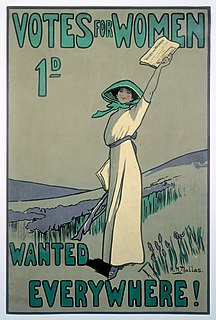
Women's suffrage in the United Kingdom was a movement to fight for women's right to vote. It finally succeeded through laws in 1918 and 1928. It became a national movement in the Victorian era. Women were not explicitly banned from voting in Great Britain until the Reform Act 1832 and the Municipal Corporations Act 1835. In 1872 the fight for women's suffrage became a national movement with the formation of the National Society for Women's Suffrage and later the more influential National Union of Women's Suffrage Societies (NUWSS). As well as in England, women's suffrage movements in Wales, Scotland and other parts of the United Kingdom gained momentum. The movements shifted sentiments in favour of woman suffrage by 1906. It was at this point that the militant campaign began with the formation of the Women's Social and Political Union (WSPU).

Pattie Ruffner Jacobs was an American women's suffragist from Birmingham, Alabama. She was inducted into the Alabama Women's Hall of Fame in 1978.

Mary Reid Anderson was a Scottish suffragist and was a leading trades unionist. She was the general secretary of the Women's Trade Union League and was involved in the formation of the National Federation of Women Workers and National Anti-Sweating League. In 1910, Macarthur led the women chain makers of Cradley Heath to victory in their fight for a minimum wage and led a strike to force employers to implement the rise. About 1901, Macarthur became a trade unionist after hearing a speech made by John Turner about how badly some workers were being treated by their employers. Mary became secretary of the Ayr branch of the Shop Assistants' Union, and her interest in this union led to her work for the improvement of women's labour conditions. In 1902 Mary became friends with Margaret Bondfield who encouraged her to attend the union's national conference where Macarthur became the first woman to be elected to the union's national executive.
Mary Josephine Donovan O'Sullivan was Professor of History at Queens College, Galway from 1914 to 1957.
Mary Fleetwood Berry was an Irish suffragist who advocated for women's right to vote between 1900–1918. Berry was a member of the Connacht Women's Franchise League, and the wife of the Reverend James Fleetwood Berry, Rector of St. Nicholas' Collegiate Church. She was an active member of the Women's National Health Association.
Sarah Persse was an Irish suffragist.
The Irish Women's Franchise League was an organisation for women's suffrage which was set up in Dublin in November 1908. Its founder members included Hanna Sheehy-Skeffington, Margaret Cousins, Francis Sheehy-Skeffington and James H. Cousins. Thomas MacDonagh was a member.

Nina Evans Allender was an American artist, cartoonist, and women's rights activist. She studied art in the United States and Europe with William Merritt Chase and Robert Henri. Allender worked as an organizer, speaker, and campaigner for women's suffrage and was the "official cartoonist" for the National Woman's Party's publications, creating what became known as the "Allender Girl."
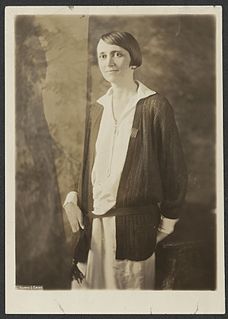
Sue Shelton White, called Miss Sue, was a feminist leader originally from Henderson, Tennessee, who served as a national leader of the women's suffrage movement, member of the Silent Sentinels, editor of The Suffragist.
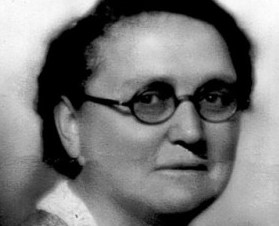
Mabel Lida Ramsay (1878–1954) was a British medical doctor and suffragist, based in Plymouth. She was the third woman to become a fellow of the Royal College of Surgeons of Edinburgh and the first woman to be president of the Plymouth Medical Society. She was decorated for her work with the Women's Imperial Service as a doctor in Belgium and France during World War I.
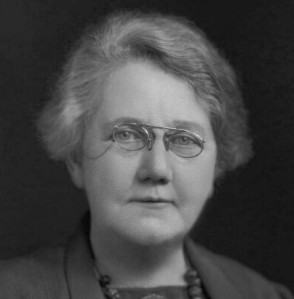
Florence Nightingale Harrison Bell was a British socialist and suffragist activist.
Edith Young , was an Irish suffragist organiser and activist.

Katharine Ludington was an American suffragist. She was the last president of the Connecticut Woman Suffrage Association, and a founding leader of the League of Women Voters.
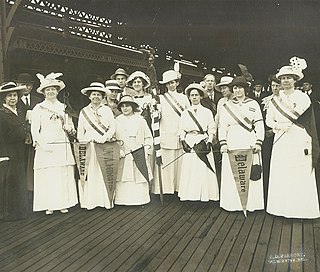
Women's suffrage in Delaware began in the late 1860s, with efforts from suffragist, Mary Ann Sorden Stuart, and an 1869 women's rights convention held in Wilmington, Delaware. Stuart, along with prominent national suffragists lobbied the Delaware General Assembly to amend the state constitution in favor of women's suffrage. Several suffrage groups were formed early on, but the Delaware Equal Suffrage Association (DESA) formed in 1896, would become one of the major state suffrage clubs. Suffragists held conventions, continued to lobby the government and grow their movement. In 1913, a chapter of the Congressional Union (CU), which would later be known at the National Women's Party (NWP), was set up by Mabel Vernon in Delaware. NWP advocated more militant tactics to agitate for women's suffrage. These included picketing and setting watchfires. The Silent Sentinels protested in Washington, D.C. and were arrested for "blocking traffic." Sixteen women from Delaware, including Annie Arniel and Florence Bayard Hilles, were among those who were arrested. During World War I, both African-American and white suffragists in Delaware aided the war effort. During the ratification process for the Nineteenth Amendment, Delaware was in the position to become the final state needed to complete ratification. A huge effort went into persuading the General Assembly to support the amendment. Suffragists and anti-suffragists alike campaigned in Dover, Delaware for their cause. However, Delaware did not ratify the Nineteenth Amendment until March 6, 1923, well after it was already part of the United States Constitution.
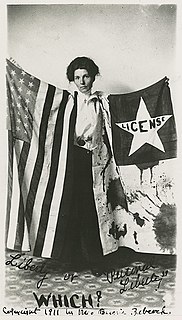
Women's suffrage in Arkansas had early champions among men in the state. Miles Ledford Langley of Arkadelphia, Arkansas proposed a women's suffrage clause during the 1868 Arkansas Constitutional Convention. Educator, James Mitchell wanted to see a world where his daughters had equal rights. The first woman's suffrage group in Arkansas was organized by Lizzie Dorman Fyler in 1881. A second women's suffrage organization was formed by Clara McDiarmid in 1888. McDiarmid was very influential on women's suffrage work in the last few decades of the nineteenth century. When she died in 1899, suffrage work slowed down, but did not all-together end. Both Bernie Babcock and Jean Vernor Jennings continued to work behind the scenes. In the 1910s, women's suffrage work began to increase again. socialist women, like Freda Hogan were very involved in women's suffrage causes. Other social activists, like Minnie Rutherford Fuller became involved in the Political Equality League (PEL) founded in 1911 by Jennings. Another statewide suffrage group, also known as the Arkansas Woman Suffrage Association (AWSA) was organized in 1914. AWSA decided to work towards helping women vote in the important primary elections in the state. The first woman to address the Arkansas General Assembly was suffragist Florence Brown Cotnam who spoke in favor of a women's suffrage amendment on February 5, 1915. While that amendment was not completely successful, Cotnam was able to persuade the Arkansas governor to hold a special legislative session in 1917. That year Arkansas women won the right to vote in primary elections. In May 1918, between 40,000 and 50,000 white women voted in the primaries. African American voters were restricted from voting in primaries in the state. Further efforts to amend the state constitution took place in 1918, but were also unsuccessful. When the Nineteenth Amendment passed the United States Congress, Arkansas held another special legislative session in July 1919. The amendment was ratified on July 28 and Arkansas became the twelfth state to ratify the Nineteenth Amendment.
References
- ↑ Ryan, Louise; Ward, Margaret (1 February 2018). Irish Women and the Vote: Becoming Citizens, New Edition. Irish Academic Press. ISBN 978-1-78855-015-4.
- 1 2 Clancy, Mary. "Florence Moon: Bringing the suffragette movement to Connacht". The Irish Times. Retrieved 26 March 2020.
- ↑ Clancy, Mary. "The 'Western Outpost': Local Government and Women's Suffrage in County Galway, 1898-1918" in Raymond Gillespie and Gerard Moran, eds., Galway: History & Society (Geography Publications 1996).
- ↑ The Industries of Ireland, Part I: Belfast and Towns of the North, the Provinces of Ulster and Connaught : Business Men and Mercantile Interests, Wealth and Growth : Historical, Statistical, Biographical : Illustrated. Historical Publishing Company. 1891. pp. 187.